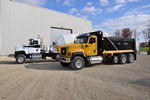 Tire-pressure changes are caused by a variety of factors. Air simply seeping through the walls of a tire can result in a small loss, depending on the materials used to manufacture the tire. Objects such as nails or tacks stuck in the tread can cause slow leaks. Overtightening of valve cores and leaking valve stems can also lead to air loss.
Tire-pressure changes are caused by a variety of factors. Air simply seeping through the walls of a tire can result in a small loss, depending on the materials used to manufacture the tire. Objects such as nails or tacks stuck in the tread can cause slow leaks. Overtightening of valve cores and leaking valve stems can also lead to air loss.
Additionally, if an operator accidentally hits a sharp rock or runs over an object on the road, air loss can occur from the impact. Losing just a few psi may not seem like a concern, but these losses over time can lead to trouble, especially when the problem isn’t noticed right away. If drivers aren’t checking every single tire on a regular basis, they may not recognize the warning signs that a tire failure could be imminent.
Dangers of Wear and Damage
According to the EPA, driving under the recommended pressure by as little as 10 psi can lead to a reduction in fuel economy between 0.5 and 1 percent. Improper inflation causes sidewalls to extend and contract, creating excessive heat and rubber fatigue. In this weakened state, tire wear is accelerated, traction is affected, and tires are more susceptible to damage.
There are also federal regulations to consider. If not followed, harsh fines could be imposed and a fleet’s operation could even be shut down. Some of these tire-related violations carry hefty penalties up to eight points, which can adversely affect the safety record for both drivers and fleets.
Severe tire damage often results in an expensive road service call, potentially taking the vehicle and the operator out of service for an extended period. The cost of roadside downtime goes beyond the obvious expense of the repair and lost time. Missing a scheduled delivery could also lead to customer dissatisfaction, putting future business in jeopardy.
Unresolved Challenges
Although the risks associated with improper tire inflation are well known, the time and labor required for proper examination can be a hindrance. Drivers earn their pay behind the wheel, so traditional walkaround tire inspections that involve taking a pressure reading of every tire can be an expensive and lengthy process.
For a fleet maintenance manager, checking the pressure of each tire on every truck in a fleet can be an extremely daunting task, yet given the efficiency, maintenance and safety benefits of proper tire inflation, it’s no surprise that fleet managers are showing increased interest in solutions that support maintaining proper pressure in their truck’s tires.
With such a strong need for fleets to improve tire maintenance, systems that monitor tire pressure have been on the market for decades. A tire-pressure monitoring system (TPMS) checks the pressure and temperature of each tire and sends an alert to the operator when it drops below a preset value.
Finding a Solution
Dana has been a longstanding leader in tire-pressure optimization with decades of experience building TPMS technology for the U.S. military. Drawing on this expertise, its engineers have developed an innovative product for the commercial-vehicle market.
Engineered to automatically maintain proper inflation for both steer and drive axles, this tire-pressure optimization system will be the only solution to offer an inflate system for all tires on a linehaul tractor. It will also feature the unique ability to deflate, which may be necessary when tires are overpressurized or when additional traction is needed.
The system will significantly minimize total cost of ownership through reduced maintenance resulting from fewer tire repairs, lower tire-replacement costs achieved through extending the life of the tires, and maximized fuel efficiency through proper inflation.
Dana is currently conducting road trials to test the system’s configuration and quantify the benefits associated with this technology. In a conservative industry where performance is critical, feedback from these trials confirms that fleet customers are aware of the downfalls of monitor-only systems.
These systems take the driver out of the equation when it comes to maintaining proper air pressure, which will become increasingly important as new technologies surface to further decrease driver engagement, such as autonomous-driving vehicles.
Dana, www.danacv.com/optimized-tire-pressure-system-calculator

